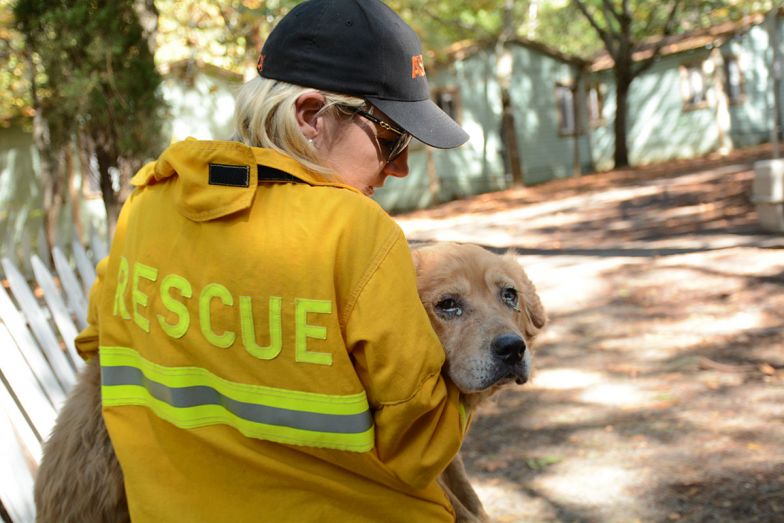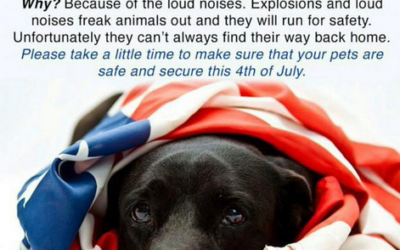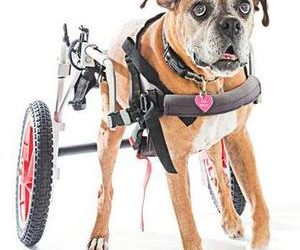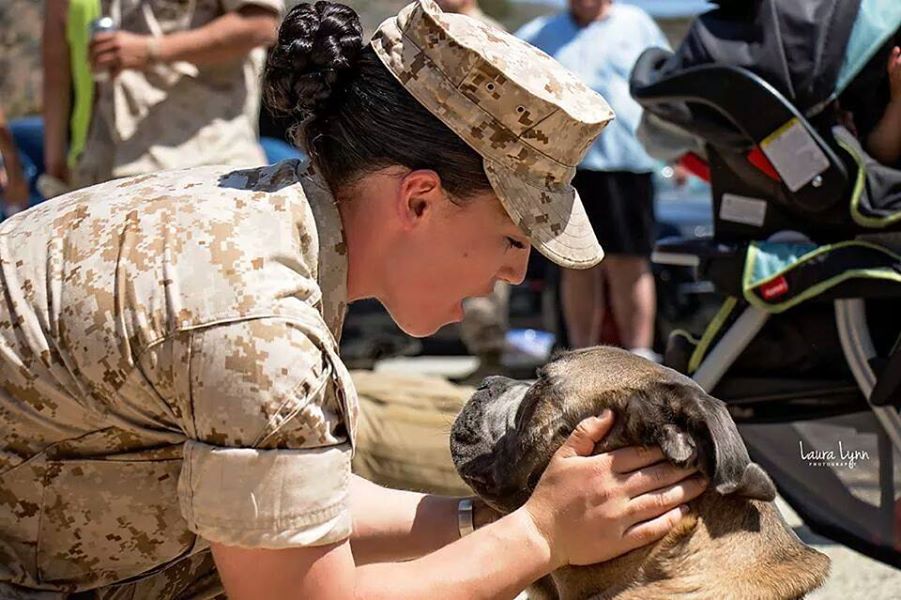Crate training is in an important part of dog ownership. Many think that it is mean or cruel to crate a dog. That is only true if the crate is used as a form of punishment. However, that is not what creating dogs was meant for. A crate should NEVER be used as...

Disaster Preparedness: What To Do in the Event of An Emergency
When disasters such as earthquakes, hurricanes, tornados, floods, or fires strike a community, the impact reaches not only people but also resident livestock and companion animals. The impact on animals can include animals getting stranded and needing rescue, or permanent separation of companion animals from their owners or fosters.
Recent disasters highlighted the need for emergency response plans that include provisions for pet evacuations and to communicate relevant information to our fosters and volunteers. It is important for the Animal Emergency Preparedness Plan to be flexible and scalable, providing the protocols needed in the event of any disaster.
What To Do in the Event of An Emergency
If you have to evacuate please take all pets in the home, including foster pets. If it’s not safe for you to remain in your home, then it is not safe for the pets in your home to remain either.
Evacuate early. Don’t wait for an emergency evacuation order. Evacuating before conditions become severe will keep everyone safer and make the process less stressful.
Be Prepared!
1. Check for and prevent any hazards that may already exist in your home such as:
- Propane tanks – ensure they are safely kept
- Monitor candles and heat emitting appliances such as ovens, stove, or clothes iron
- Don’t overload electrical outlets
- Test smoke alarms frequently to ensure they are in working order
- Purchase a fire extinguisher and learn how to use it
- Prevent carbon monoxide leaks by having your HVAC system, water heater, and other appliances that use gas, oil, or coal serviced by a professional every year
- Make sure to always keep anything that gives off heat at least 3 feet away from flammable materials or items
- If you have a fireplace, make sure your chimney is checked and cleaned by a professional once a year. Use a metal or glass screen that is large enough to prevent escaping embers
- Check the testing labels on all major appliances that indicate you purchased them in safe working order. You may not find testing labels on older appliances, so consider whether it’s time to replace them or have them checked by a professional.
- Avoid cluttering debris or junk near a furnace, heater or nay heat source
2. Make sure that all information on identification tags and microchips are current and that both include your cell phone number and the contact information of a backup contact.
3. Prepare a disaster kit that includes:
- Food & water for at least 5 days
- Bowls
- Manual can opener
- Medications and vet records
- Litter, litter boxes and/or poopie bags
- Harnesses, collars with tags (preferably martingale collars so your dog can’t “back out” of the collar in fear), leashes and crates/carriers
4. In the event another foster home is needed, write down anything a temporary foster may need to know about your pet(s) and foster pet(s) including behavior, feeding times, any medical issues, medication, etc.
5. Develop an evacuation transport plan including where pets will immediately go in an emergency (car, neighbor’s house, etc). Determine the number of crates or carriers needed, and an emergency destination (Red Cross or FEMA shelter, family or friend’s house, vet’s office, etc.).
- Contact hotels/motels that are at least 50 miles from you to see if they take pets during an emergency.
- Other essential supplies to store in a secure room in the home:
- Nonperishable food
- Bottled water
- Battery-powered radios
- First-aid supplies
- Flashlights
- Batteries
- Duct tape
- Plastic sheeting
- Plastic garbage bags
Fires and Emergency Situations in the Home
In the event of a fire or emergency situation, call 9-1-1 immediately! Then:
- Notify all people in your home as soon as possible by sounding any form of alarm- air horn, whistle, smoke alarm, or verbal.
- Provide instructions to all occupants of the home as to where to exit and where to go once they exit the home.
- Once all occupants including pets in the home are safe and emergency personnel have arrived on the scene, contact a friend or family member to notify them of the emergency and your location. Also provide an alternate contact number for anyone who is with you.
Under no circumstances should you attempt to fight a fire that has passed the incipient stage (that which can be put out with a single fire extinguisher), nor should you attempt to enter a burning building to conduct search and rescue. These actions should be left to emergency services professionals who have the necessary training, equipment, and experience (such as the fire department or emergency medical professionals). Untrained individuals may endanger themselves and/or those they are trying to rescue.
Evacuation Routes
Develop an evacuation route plan of your home, assign a Designated Assembly Area or Evacuation Site for your home.
- Designated Assembly Area (DAA) is an outside location at least 50 feet from the building, away from roads and walkways used by emergency vehicles
- Evacuation Site (ES) a building in close proximity to the evacuated building that will provide protection from the weather or other elements in the case of a prolonged evacuation.
If an emergency occurs while at home or work, local emergency personnel will instruct and direct you to the nearest DAA or ES.
Discuss all emergency evacuation plans with all members of your household.
- Appoint 1-2 people responsible for evacuation assistance in your home.
- In the event that a fire/emergency alarm is sounded or instructions for evacuation are given:
- Everyone should immediately exit the premises/building(s) at the nearest exits, as shown in the escape route
- Meet as soon as possible at the Designated Assembly Area.
- The people responsible for evacuation are to check all rooms for occupants and pets.
- Once a room has been checked and cleared, close the door to that room, but leave it unlocked. This will decrease the chances of a fire spreading.
- Leave home exit doors open to allow any pets that may remain to escape to the outdoors. If you must, break a window to the room where you think pets may be hiding.
Securing Property and Equipment
In the event that evacuation of the premises is necessary make sure that gas mains, electricity breaker boxes and water mains are shut off. Determine who in your home will be responsible for shutting off this equipment in your home.
Accounting for members of your household after an evacuation
Once a home evacuation has occurred to an evacuation site, an adult should account for each person and pet that was in the home and report this to emergency personnel.
Home Evacuation Re-entry
Once your home has been evacuated, do not re-enter it for any reason. All members of the home should remain at the Designated Assembly Areas or Evacuation Sites until the fire department or other emergency response agency notifies you that either it is safe to re-enter, or if relocation to a new location is discussed and determined.
Sheltering in Place: When not to evacuate
In the event of an emergency where authorities may determine that it is safer to remain where you are rather than evacuate in such instances as chemical, biological, or radiological contaminates have been released into the environment in such quantity and/or proximity to your home, please follow all instructions by emergency personnel and do the following:
- Immediately lock exterior doors and close windows, doggy doors, and air vents.
- Turn off, seal, or disable all fans, heating and air conditioning systems, and clothes dryers, especially those systems that automatically provide for exchange of inside air with outside air.
- If there is a danger of explosion, close the window shades, blinds, or curtains.
- Ensure all pets are inside.
If you have a room you can designate as a “safe room,” put your emergency supplies in that room in advance. A safe room is a room that has no windows or exposure to the outside such as a walk-in closet, bathroom, basement or underground shelter. Bring all supplies listed above (pet crate and supplies, any medications and a supply of pet food and water inside watertight containers, along with your other emergency supplies.) If there is an open fireplace, vent, pet door or similar opening in the house, close it off with plastic sheeting and strong tape.
Write down the names of everyone in the home and inform emergency personnel outside of the building of who is in the room. Listen to the radio, monitor TV, phone or check Facebook updates. Do not come out until you know it’s safe and have been instructed to do so by emergency personnel.
Reporting Emergency Situations
All emergency situations must be reported as soon as possible. Emergency situations may include but are not limited to fires, earthquakes, floods, vehicle accidents during animal transport, injuries incurred by human or animal from bites and animal injuries incurred during physical exercise.
We want to ensure all members of your home are safe and accounted for in case of an emergency – both people and pets. For more information and tips on emergency situations, please visit the Red Cross and FEMA web sites. Also, please contact your local animal shelter and discuss their emergency plans for animal evacuations. You should also contact neighbors, family and friends to discuss emergency plans.
Tips for Crate Training Your Dog
How to Handle Your Pets’ Stress During a Crisis
In times of crisis, there is no better companion than a pet. There are countless articles and research showing the mental and health benefits that come with caring for a pet. Pets are wonderful at helping us cope with stress, and there is no better time for the...
4 Tips to Help Your Cat and Dog Get Along Better
Sponsored by AlliVet Having multiple furry friends in your home can be fun and fulfilling. However, if you have animals of different species -- like dogs and cats -- it can also be challenging. Many dogs and cats don't naturally react well to one another, which means...
How to Deal with the Loss of a Pet
They say our pets are like family. I say, they’re not “like” family; they are family, and when you lose one, it’s a like a part of your heart and soul gets ripped out and taken with them. As the co-founder of PPITS, I’ve seen my fair share of pet loss. It is...
Disaster Preparedness: What To Do in the Event of An Emergency
When disasters such as earthquakes, hurricanes, tornados, floods, or fires strike a community, the impact reaches not only people but also resident livestock and companion animals. The impact on animals can include animals getting stranded and needing rescue, or...
4th of July Pet Safety: Think Twice Before You Light
Pets and 4th of July fireworks don't mix! Did you know: Animal control officers across the country have reported up to a 60% increase in shelter intakes between July 4 - July 6? The most they see all year! Many animals get very frightened and stressed at the sight...
Miss Animal Rights Awareness Week? No Problem! There is Always Time to Help Animals in Need
Animal Rights Awareness Week might have been last week, but there is still time to get involved. We thing every day should be dedicated to animals and give a voice to the voiceless! Animal Rights Awareness Week was created to provide education and tools in the fight...
Memorial Day Pet Safety Tips
Memorial Day is the day Americans gather together to memorialize the veterans who made the ultimate sacrifice for their country. It is also considered the unofficial start of summer and with that, there’s the chance you will celebrate with friends and family members,...
What To Do If You Find Kittens
In a recent blog post, we discussed “kitten season,” the time of year when the kitten population seems to explode and can be extremely overwhelming for rescues and shelters alike. Because we are right in the middle of kitten season now, we wanted to expand on what you...
It’s Kitten Season! Here’s What You Need to Know
Spring has sprung, and that means that “kitten season” is here! While kittens are some of the most adorable creatures on the planet, kitten season can be overwhelming for animal shelters and rescues who end up caring for the abundance of tiny baby kitties that are...
Puppy Mill Awareness
Today marks the beginning of Puppy Mill Action Week. There aren’t many things that are cuter in the world than a puppy. That breath! Those eyes! And of course, all of the unconditional love they bring. Deciding to get a puppy is a big decision, but perhaps even more...
How to Reduce Separation Anxiety in Your Dog
Written by: Duncan Kingori, AuthenticDogs Like humans, our pets also experience separation anxiety. In dogs, separation anxiety is characterized by agitation, upset, and even destructive behavior. These behaviors are exhibited by dogs when they are separated from...
Caring for a Senior Pet
November is National Adopt a Senior Pet Month! Here at PPITS, we love our senior pets. We even created a program called Murray's Purpose for at-risk senior shelter pets. If you've been thinking about adding a senior pet to your home, or if your current pet is starting...
Working From Home With Pets
So many of us have found ourselves working from home over the course of the last year. And for pet parents, this has caused an abrupt and unexpected change in routine for our four-legged family members. Let’s face it: our pets love having us at home, but it’s not...
Newly Adopted Dog Checklist: What You Need to Do and Buy for Your New Pet
Written by: Trevor James, DogLab So you got a new dog? Congratulations! We hope it’s a rescue dog, of course. 😉 If this is your first time as a canine parent, then you should know that there are several things you need to do and buy before bringing your new pup home...
Four Common Cleaning Chemicals That Are Toxic to Pets
By: James Hall, Freelance Writer and Home Cleaning Expert, @Spotless_Vacuum It’s no secret that many household cleaning products are toxic to humans. A quick glance at a label shows just how careful we need to be when cleaning our homes. These chemicals are even more...
PAW PRINTS IN THE SAND ANIMAL RESCUE ANNOUNCES ITS SENIORS FOR SENIORS FOSTER PROGRAM
The Program is Designed to Help Save and Enrich Lives by Rescuing Senior Shelter Pets and Giving Senior Citizens in Retirement Homes and Assisted Living Facilities the Opportunity to Foster and Care for Them. Newport Beach, Calif....
October is Adopt A Shelter Dog Month
Adopt-A-Shelter Dog Month What Can An Adopted Dog Bring To Your Life? For millions of dogs, there’s something special about the month of October. No, it’s not holiday sweaters or Halloween treats. It’s the promise of a better life. You see, October is Adopt a Shelter...
Celebrate National Pet Month By Getting in Shape with Your Pet
May is National Pet Month, and what better way to celebrate than spending time with your furry friends while staying healthy at the same time? Because no one likes to exercise more than your four-legged friend, here are some great ways to workout with your pets:...
April is National Prevention of Animal Cruelty Month
Even though Paw Prints in the Sand works year-round to prevent and bring awareness to cruelty to animals, April is special because it is officially the ASPCA’s Prevention of Cruelty to Animals Month! We are asking supporters to celebrate by joining us in raising...
PAW PRINTS IN THE SAND LAUNCHES THE ‘FROM SHELTER TO SERVICE’ PROGRAM
The Organization Will Work to Help Combat Veterans and People with Disabilities While Reducing Shelter Overpopulation Newport Beach, Calif., - February 21, 2018 – Paw Prints in the Sand Animal Rescue, a 501(c)(3) nonprofit animal welfare organization, today announced...
PAW PRINTS IN THE SAND ANNOUNCES ‘MURRAY’S PURPOSE’, A NEW PROGRAM FOR AT-RISK SENIOR SHELTER PETS
The Program is Designed to Save Late-Stage Senior Pets in Southern California Kill Shelters and Provide Them with Hospice Care Newport Beach, Calif., - January 23, 2018 – Paw Prints in the Sand Animal Rescue, a 501(c)(3) nonprofit animal welfare organization, today...
Special Needs, Special Deeds
“Special needs pets need special people!” This is a phrase that we hear frequently from rescues encouraging people to adopt special needs pets. But why is that? Is it because of the sacrifice we are willing to give and the extra...
A Rescuer’s Insight on Breed Specific Legislation
The following guest post was originally posted by the Paw Prints in the Sand Co-Founder and President in Pet Rescue Report What is BSL? BSL stands for Breed Specific Legislation, which essentially makes certain dog breeds illegal based on their looks or breed. The...



























 The Program is Designed to Help Save and Enrich Lives by Rescuing Senior Shelter Pets and Giving Senior Citizens in Retirement Homes and Assisted Living Facilities the Opportunity to Foster and Care for Them.
The Program is Designed to Help Save and Enrich Lives by Rescuing Senior Shelter Pets and Giving Senior Citizens in Retirement Homes and Assisted Living Facilities the Opportunity to Foster and Care for Them. 

Recent Comments